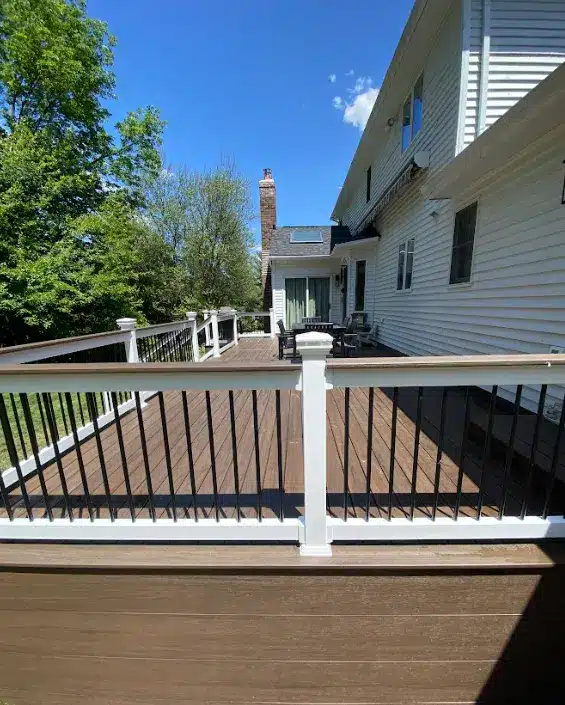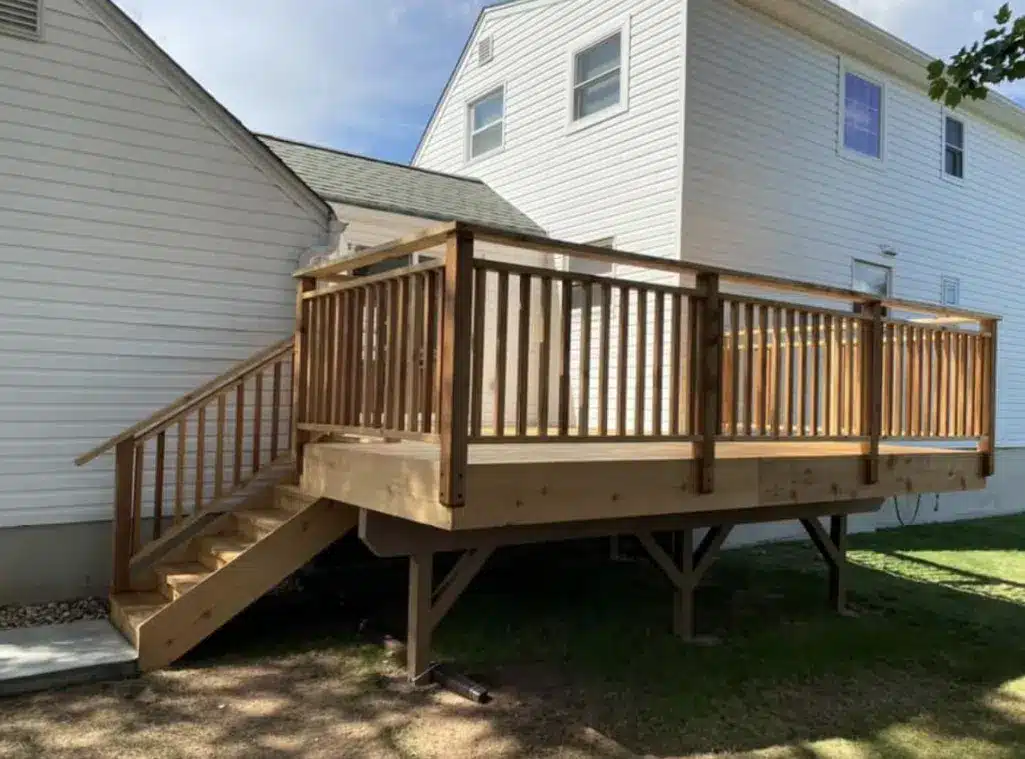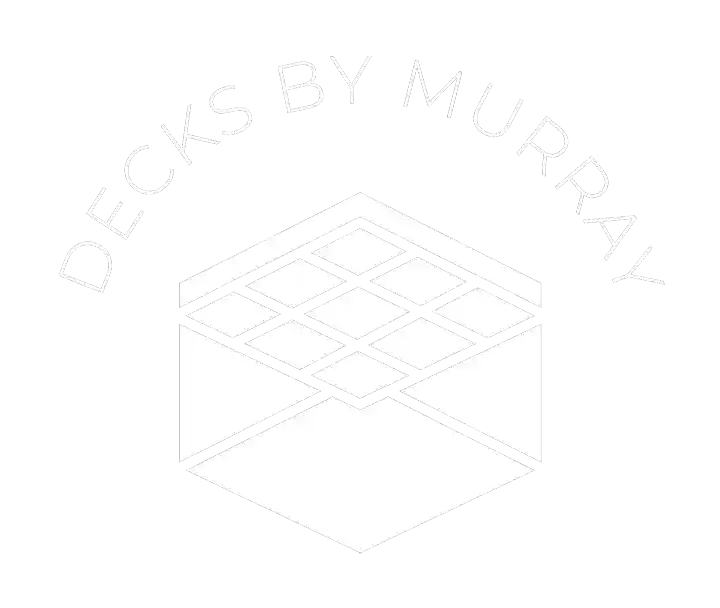Pressure-Treated Decks in North New Jersey
Pressure-treated decks offer homeowners a durable, cost-effective solution for enhancing their outdoor living spaces. At Decks By Murray, we specialize in creating high-quality backyard decks designed to withstand the elements and provide long-lasting enjoyment.
Homeowners can rely on Decks By Murray for expertly crafted pressure-treated decks that combine strength and aesthetic appeal. Our team ensures each wood deck is built to meet your needs, providing a functional and beautiful addition to your home.
What is Pressure-Treated Lumber?

Pressure-treated wood is lumber infused with preservatives to protect it from rot, fungal decay, insect damage, termite damage, and water damage. This treatment process extends the lifespan of the wood, making it an ideal choice for outdoor structures like decks.
Pressure-treating wood involves placing the lumber in a large, airtight cylinder. The cylinder is then pressurized with a liquid chemical treatment, forcing the preservative deep into the wood fibers. This thorough saturation ensures that the wood is well-protected against environmental hazards.
Common types of wood used for pressure-treated decks include Southern Yellow Pine, Douglas Fir, and Hem-Fir. These species are chosen for their strength, availability, and ability to absorb the preservative treatment effectively.
Benefits of Pressure-Treated Decks
Pressure-treated decks offer numerous advantages over untreated lumber, making them a good choice for homeowners looking to enhance their outdoor living spaces.
- Longevity and Durability: This type of wood decking is designed to withstand the elements, ensuring your deck lasts for many years. Its enhanced resistance to rot, decay, and insect damage means it remains structurally sound and visually appealing over time.
- Cost-Effectiveness: Compared to other decking materials, like composite decking, pressure-treated wood is more affordable. This cost-effectiveness allows homeowners to achieve a high-quality, durable deck without breaking the bank, making it a popular choice for budget-conscious projects. However, over time, it can become costlier because of the maintenance needed.
- Resistance to Rot and Insect Damage: As noted, the preservatives used in pressure-treated wood help protect it from several problems and maintain the deck’s structural integrity.
Comparing Pressure-Treated Decking with Other Types of Decking Materials

Homeowners have several options when choosing decking materials, each offering unique benefits and potential drawbacks.
- Composite Decks: Composite decking boards, made from wood fibers and plastic, provide a low-maintenance and highly durable option. They resist rot and insect damage without preservatives and do not splinter or warp. However, composite decks can be more expensive initially.
- Cedar or Other Natural Wood Decks: Cedar and other natural woods are valued for their beauty and natural resistance to decay and insects. These decks offer a rich, organic look that many homeowners find appealing. However, they typically require more maintenance, including regular staining and sealing, to protect the wood and maintain its appearance. Additionally, natural wood decks can be more costly than pressure-treated options.
- Pressure-Treated Decks’ Advantages and Drawbacks: Pressure-treated decks balance affordability, durability, and ease of maintenance. They are less expensive than composite and natural wood options while offering longevity and resistance to environmental hazards. They can be stained or painted to fit any design preference, providing flexibility in aesthetics. However, pressure-treated wood may not have the same premium look as cedar and can require periodic maintenance to retain its appearance and structural integrity.
Deck Design and Customization Options

Pressure-treated decks offer a number of customization options to fit any homeowner’s style and needs.
- Variety of Design Options: Pressure-treated wood can be shaped and styled to match any vision, from traditional to contemporary designs. This versatility allows homeowners to create unique and personalized outdoor spaces.
- Staining and Painting Possibilities: The options for staining and painting pressure-treated deck boards are virtually endless. Homeowners can choose natural wood finishes, bold colors, or subtle shades to complement their home’s exterior. Staining or painting enhances the deck’s appearance and adds extra protection against the elements.
- Integration with Other Outdoor Features: Pressure-treated decks can seamlessly integrate with various outdoor features like pergolas or covered structures. The flexibility of pressure-treated wood allows for additions such as built-in seating, planters, or outdoor kitchens, creating a cohesive and inviting outdoor living space.
Why Choose Decks By Murray for Your Deck Project?
Decks By Murray delivers expert craftsmanship and customized solutions for every outdoor project, using high-quality materials to ensure durability and longevity. Our comprehensive services cover everything from design to final inspection, making the process seamless and stress-free. With a focus on customer satisfaction, we create beautiful, functional outdoor spaces that exceed homeowners’ expectations. Trust Decks By Murray for your pressure-treated deck or any other decking needs.
Pressure-Treated Decks FAQs
Pressure-treated wood is a popular choice for decking due to its affordability and durability. This type of decking material is treated with chemical preservatives that help protect it from termite attacks, rot, and physical damage caused by moisture.
Inspecting your pressure-treated deck at least once a year is recommended. Look for signs of physical damage, such as cracks or splinters, as well as any signs of termite attacks or decay. Regular inspections can help you identify and address issues early, ensuring the longevity and safety of your deck.
Modern pressure-treated wood is treated with safer chemicals than before, reducing environmental concerns. However, following proper disposal methods for any wood waste is essential.





